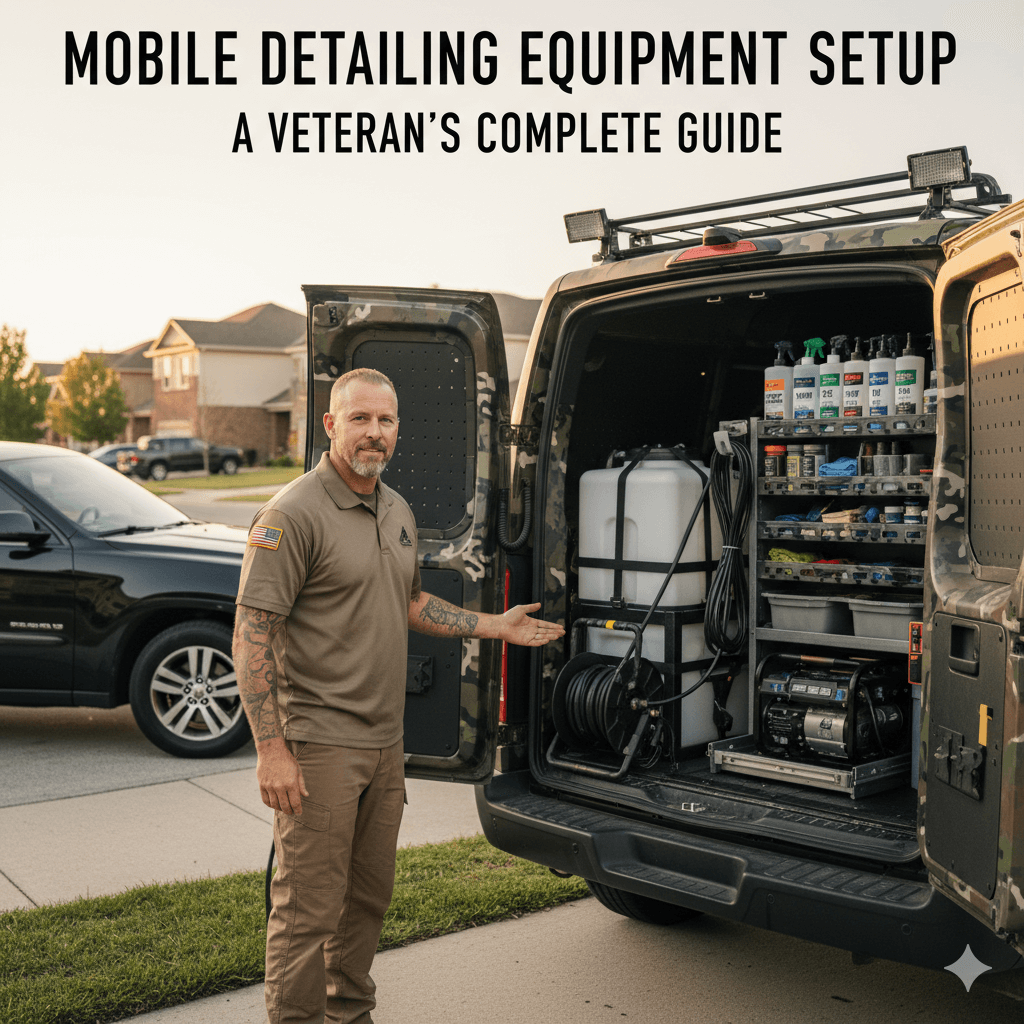
I still remember my first attempt at mobile detailing back in the mid-90s. I loaded my old Chevy van with buckets, rags, and a vacuum that barely worked. By the end of that summer, I had learned the hard way: if your setup isn’t efficient, you’ll waste more time wrestling with equipment than actually detailing cars.
Today, mobile detailing is one of the fastest-growing branches of the auto care industry. Car owners love the convenience, and detailers like you and me love the flexibility. But to succeed, you need the right mobile detailing equipment setup—organized, reliable, and tailored for real-world jobs.
In this guide, I’ll share what I’ve learned in 30+ years of detailing—from cleaning muddy pickups after hunting trips to polishing high-end sports cars in client driveways. We’ll cover everything: the must-have tools, how to organize your mobile rig, and insider tricks to avoid rookie mistakes.
Why Mobile Detailing Equipment Setup Matters
A professional setup does more than just make your van look impressive. It impacts:
- Efficiency – Less time fumbling, more time detailing.
- Professionalism – Customers trust you more when you look prepared.
- Profitability – Faster jobs = more clients = more income.
- Longevity – Quality gear lasts longer and saves money in the long run.
Think of it this way: your setup is your rolling workshop. Would you trust a carpenter who shows up with rusty tools tossed in a plastic bag? Same goes for detailers.
The Essentials – Mobile Detailing Equipment List
Here’s the foundation every mobile detailer needs.
1. Water Supply
Not every client will have a hose available. A water tank is a must.
- Recommendation: 50–100 gallon tank for solo operators.
- Pair with a 12V pump to maintain steady pressure.
- For eco-conscious areas, consider a waterless wash system.
2. Pressure Washer
Skip the heavy gas-powered ones—they’re noisy and overkill.
- Best choice: 1,500–2,000 PSI electric pressure washer.
- Brands: AR Blue Clean, Sun Joe, Kranzle.
- Use quick-connect fittings for efficiency.
3. Generator
You’ll need reliable power on the go.
- Size: 2,000–3,000 watts minimum.
- Honda EU2200i is the gold standard (quiet, durable).
- Inverter generators are quieter and fuel-efficient.
4. Vacuum Cleaner
A good vacuum separates pros from amateurs.
- Wet/dry capability is essential.
- Strong suction with long hose.
- Rigid and VacMaster are solid brands.
5. Dual-Action Polisher
Polishers aren’t just for paint correction—they save hours on wax and sealant.
- Brands: Griot’s Garage, Rupes, Flex.
- Stock different pads for cutting, polishing, and finishing.
6. Chemicals & Cleaners
You’ll need a product arsenal:
- All-purpose cleaner (APC)
- Car shampoo (pH neutral)
- Degreaser (for engines and wheels)
- Glass cleaner
- Wax/sealant/ceramic coatings
- Interior protectant
Pro Tip: Stick to reputable brands like Meguiar’s, Chemical Guys, or 3D Products. Customers notice quality.
7. Towels, Pads & Brushes
- Microfiber towels – at least 50–100 in rotation.
- Detailing brushes – for vents, emblems, and tight spots.
- Applicator pads – foam and microfiber.
- Wheel brushes – soft bristle for faces, stiff for barrels.
8. Steam Cleaner (Optional but Powerful)
For interiors, nothing beats steam. It sanitizes, lifts stains, and makes you stand out.
Organizing Your Mobile Detailing Setup
Van/Trailer Layout
- Mount your water tank at the center (for balance).
- Keep heavier items low to avoid tipping.
- Use shelving for chemicals and towels.
- Add hose reels for water and power cords.
Efficiency Tips
- Color-code towels (interior vs exterior).
- Pre-fill bottles with diluted chemicals.
- Keep a “grab-and-go” bucket for quick jobs.
When I started, I wasted 10 minutes per job just untangling cords. Once I invested in reels and proper shelving, I cut job times by 20%. That’s money in your pocket.
Common Mistakes Beginners Make
- Overbuying equipment – You don’t need every gadget right away.
- Cheap chemicals – They leave streaks, stains, and angry customers.
- Poor water management – Always have a backup plan if your tank runs dry.
- Ignoring maintenance – Clean filters, flush pumps, check hoses weekly.
- Disorganized setup – Clutter slows you down and looks unprofessional.
Pro Tips / Insider Hacks
- Quick Connect Everything: Hoses, sprayers, power cords—time is money.
- Carry Extra Belts & Hoses: A busted hose mid-job can ruin your day.
- Use Clear Bottles: Easy to see chemical levels.
- Have a Spill Kit: Customers appreciate professionalism when accidents happen.
- Invest in Lighting: Portable LED lights help with swirl mark inspections.
Cost Breakdown – What to Budget
Starting small? Here’s a rough estimate:
- Water Tank + Pump: $500–$800
- Pressure Washer: $200–$500
- Generator: $800–$1,200
- Vacuum: $150–$300
- Polisher: $200–$400
- Towels, Brushes, Buckets: $200–$400
- Chemicals: $300–$600
- Shelving & Reels: $300–$600
Total: $2,500–$4,500 (budget setup)
Premium Setup: $7,000–$12,000+
DIY vs Professional Setup
- DIY: Cheaper, but requires more trial and error.
- Professional Van Outfitting: Faster, cleaner, but costly.
I did my first build DIY. It wasn’t pretty, but it worked. Years later, I had a professional outfit my van—it saved time but cost triple. Both paths work; it depends on your budget.
Mobile Detailing in the Modern World
Back in the day, people didn’t trust mobile detailers. They wanted a shop. Today? Convenience rules. Customers want service at home, at the office, even at the golf course.
Future trends:
- Eco-friendly setups (waterless, low-noise).
- EV detailing (battery-safe cleaning).
- App-based booking systems.
Key Takeaways
✅ A reliable mobile detailing equipment setup is your foundation.
✅ Prioritize efficiency and organization.
✅ Start with essentials, expand as you grow.
✅ Don’t skimp on towels, chemicals, or vacuums.
✅ Professional presentation = repeat customers.
FAQs
1. Do I need a van to start mobile detailing?
Not always. Some start with a trailer or even an SUV. A van is more efficient long-term.
2. How much water do I need per car?
On average, 10–15 gallons per wash with efficient methods.
3. Can I start without a generator?
Yes, if clients provide power. But a generator makes you independent.
4. What’s the best polisher for beginners?
A dual-action (DA) polisher—safe, versatile, and effective.
5. How often should I replace microfiber towels?
When they lose softness or leave streaks. Rotate often.
Conclusion – The Setup is Your Success
When I think back to my early mobile detailing days, I laugh at how messy my setup was. But I also remember the lessons—it taught me that organization and equipment matter just as much as skill.
A smooth, professional setup doesn’t just save you time. It builds trust. Customers notice when you show up looking prepared, efficient, and confident.
So if you’re planning your mobile detailing equipment setup—start smart, invest wisely, and keep improving. One day, you’ll look back like I do, proud of how far a simple van of tools took you.
Because in this business, your setup isn’t just equipment. It’s the engine that drives your success.
🔗 Related Reads:
- [What Equipment Do I Need to Start a Car Detailing Business?]
- [Is Mobile Car Detailing a Good Business?]
- [How to Start a Car Detailing Business from Home]

